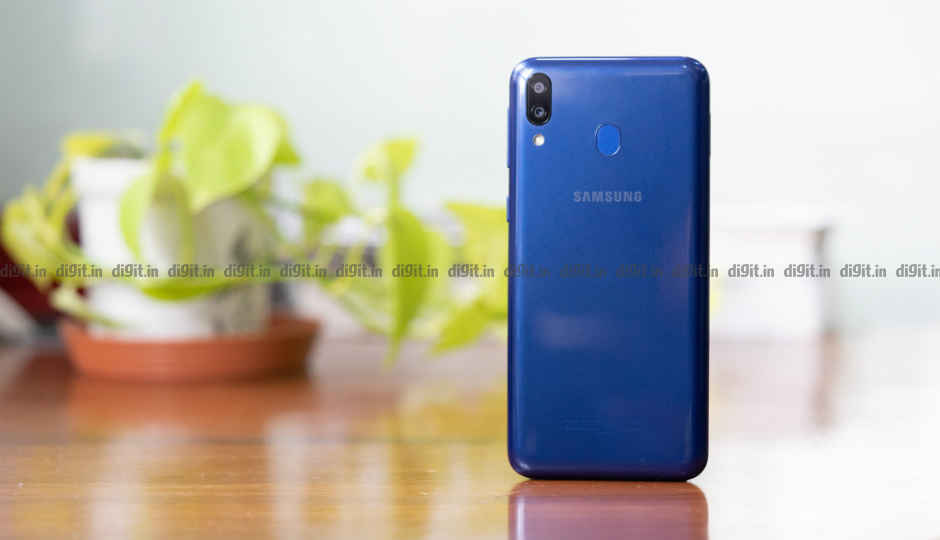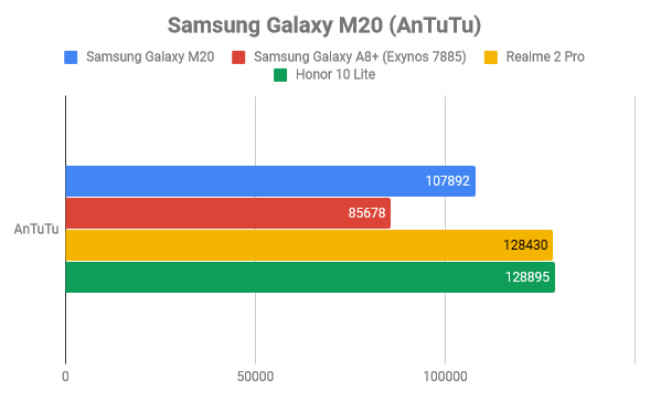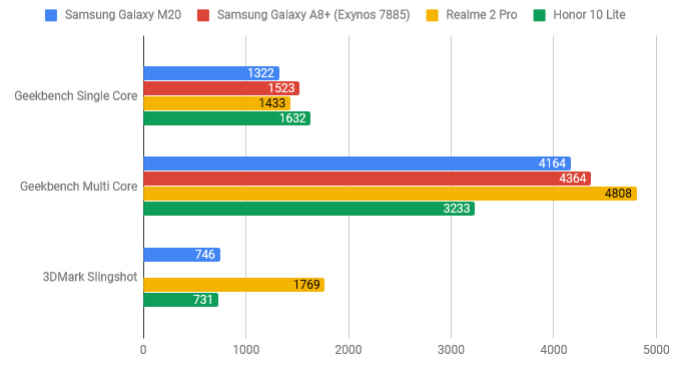Samsung Galaxy M20 performance tested: Should the Chinese OEMs feel threatened?
Samsung believes the M20 is the answer to the dominance of Chinese manufacturers. We put those claims to test.

There was a time when Samsung was the first name that would come to mind when one thought of a good smartphone that works well. Then came the Chinese onslaught. The likes of Xiaomi, Honor, Oppo, Vivo and the likes chiseled away market share from the Korean giant, especially in the affordable segment. The biggest ploy of the Chinese OEMs was offering a spec-sheet that went unmatched in that price range. But not Samsung. The Korean giant believed in offering a good experience, and not the best spec-sheet around. But then there was a major change in the way Samsung strategised. Over time, the company’s mid-range and high-end phones became the harbingers of latest tech. The Galaxy A7 and the Galaxy A9 introduced triple and quad camera setup to Samsung phones, while the Galaxy A8s (not released in India) became the first to offer a punch-hole display. That was more or less enough to generate the buzz Samsung needed to snatch back lost market share. Whether it worked or not is something that requires further investigation, but it certainly gave us an interesting time reviewing the phones.
 Survey
SurveyFast forward to the Galaxy M10 and the Galaxy M20, a new series that Samsung introduced to draw the millennials back to the brand. It’s supposed to reinvigorate the mid-range segment that Samsung had been flooding with average-performing, mediocre devices. The Galaxy M10 and the M20, as far as Samsung is concerned, is a radical new offering. It innovates on a new design, introduces a new chipset and brings an ultra-wide angle camera to the budget and mid-range segment. As a result, the list of features on the Galaxy M10 and especially the Galaxy M20, should ideally be enough to be considered worth a buy, but these days, you never can tell. To really see whether the Galaxy M20 is a considerable challenger to Chinese OEMs, we tested how the Galaxy M20 with the new Exynos 7904 octa-core chipset performs against the Snapdragon 660-powered Realme 2 Pro and Asus Zenfone Max Pro M2, and the Kirin 710 powered Honor 10 Lite.
How new is the new Exynos 7904 SoC?
While Samsung claims the Exynos 7904 SoC is a brand new chip, it’s a lot similar to the Exynos 7885 octa as it turns out. Both chipsets are based on a 14nm manufacturing process. Also, both octa-core chipsets are arranged in a 2+6 cluster with two Cortex A73 cores clocked at 1.8GHz and six Cortex A53 cores clocked at 1.6GHz. The two cores are used for processor-intensive tasks like gaming while the other six cores are used to handle the daily usage like browsing Facebook and taking photos. The only major difference in the two is that the new Exynos 7904 has support for three cameras while its predecessor supported only two. As a result, we didn’t expect a big difference between phones powered by the two chipsets and it showed in the benchmarks.
The Samsung Galaxy M20 with the new Exynos chip scored 107892 on AnTuTu, while on Geekbench Single Core and Multi Core tests, the Galaxy M20 scored 1322 and 4164 respectively. However, unlike what we predicted, the Exynos 7904 did outperform the Exynos 7885. The Samsung Galaxy A8+ powered by the Exynos 7885 octa scored 85678 on AnTuTu while on Geekbench single and multi core tests, it scored 1523 and 4364 respectively.
In comparison, the Snapdragon 660-powered Realme 2 Pro scored 128430, which is much higher than what the Galaxy M20 scored. Similarly, on Geekbench Single Core and Multi Core tests, the Realme 2 Pro scored 1433 and 4808, which incidentally is higher, but not by a lot. The Kirin 710-powered Honor 10 Lite is a little ahead with 128895 on AnTuTu, 1632 on single core but with a lower score of 3233 on multi-core tests on Geekbench.
As far as synthetic benchmarks are considered, the CPU performance of the Galaxy M20 is more or less similar to the other mid-rangers in the market right now. However, it’s the GPU on the Galaxy M20 that might not be enough for games like PubG Mobile. The Exynos 7904 on the Galaxy M20 relies on a Mali-G71 MP2 for graphics, same as the Kirin 710-powered Honor 10 Lite. However, unlike the latter, Samsung doesn’t have GPU Turbo to make the most of an ageing GPU.
On 3DMark Slingshot, the Galaxy M20 scored a measly 746. The score is very much similar to that of the Honor 10 Lite which scored 731. Both phones are outperformed by the Realme 2 Pro with 1769 points. Clearly, the Adreno 512 GPU is way ahead than the rest in that price range, making the phones powered by the mid-range Snapdragon chipset better suited for gaming.
The Galaxy M20 PUBG Test
Considering the Galaxy M20 is aimed at millennials, and all the rage among millennials is the popular battle-royale game PUBG Mobile, we did the most obvious performance test. We played PUBG Mobile on it, and recorded the performance on Game Bench. We played a 20 minute session to see how the GPU fares against the one on the Asus Zenfone Max Pro M2 and the Honor 10 Lite, both of which posted the highest stats we have seen in mid-range phones.
The Galaxy M20 managed to deliver median frame rate of 22 fps with a variability index of 1.8 and FPS stability of 78 percent. As expected, the phone’s performance while playing PUBG Mobile is nowhere close to other mid-range Android smartphones. Even though the Honor 10 Lite has the same GPU under the hood, the GPU Turbo 2.0 on the phone actually makes the game run better than the Snapdragon-equipped Asus Zenfone Max Pro M2.
The Honor 10 Lite delivered stable median frame rate of 30 FPS with 89 percent stability, while the Asus Zenfone Max Pro M2 delivered 26 FPS but with a higher 96 percent stability. Clearly, the Galaxy M20 is not the best phone for playing high-end games.
The Samsung Galaxy M20 might be Samsung’s answer to the powerful mid-rangers sweeping the market, but it doesn’t seem to match the performance of its rivals. It’s aimed at millennials who happen to be quite involved in mobile gaming, and even then it failed to live up to the expectations.
However, it’s still too early to discount the phone. The Galaxy M20 may not be a good performer when it comes to handling heavy tasks, but it does offer a one-of-its-kind ultra wide-angle lens under Rs 15,000, making it the only phone to do so, apart from the Samsung Galaxy M10. We are in the process of testing the camera to see whether it’s any good, and we will let you know about it in another feature. Let us know what you think about the Galaxy M20 in the comments.


